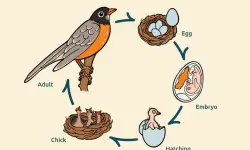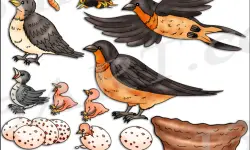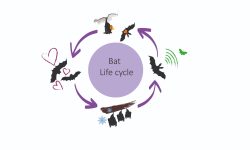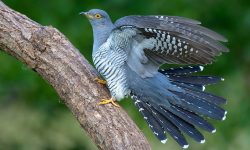Michigan is a waterfowl hotspot, with vast lakes, marshes, and open fields attracting geese year-round. While the Canada Goose is a familiar sight, the state is home to a variety of other wild geese, some of which are regular migrants, while others are rare but exciting visitors. This guide explores seven wild goose species you may encounter across Michigan.
1. Canada Goose (Branta canadensis)
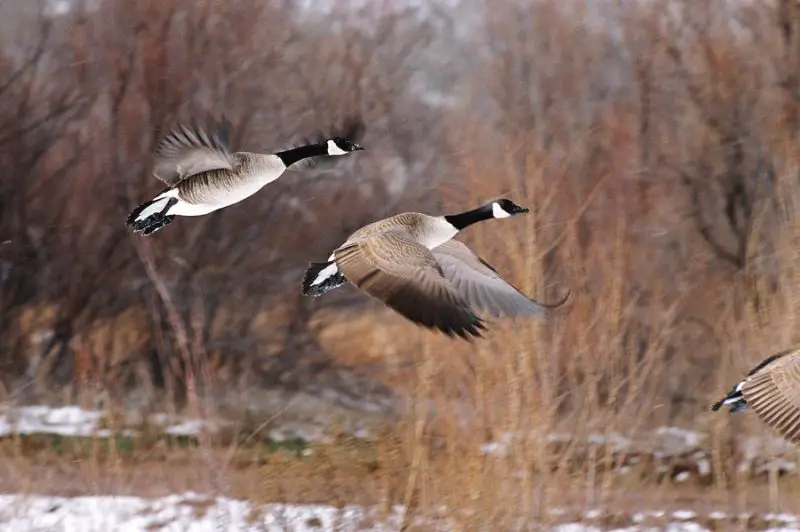
Michigan’s Icon of the Skies and Shores
No bird is more closely associated with Michigan’s lakeshores, city parks, and open fields than the Canada Goose. As the most common and widespread goose in the state, this majestic bird with a black head, white chinstrap, and chocolate-brown body has become a year-round presence in both wild and urban landscapes.
Canada Geese are impressively adaptable. Once migratory, many populations have now established permanent residency in southern Michigan, thriving on manicured lawns, golf courses, and retention ponds where food is plentiful and predators are few. Their ability to coexist with human development—sometimes to the point of nuisance—makes them a fascinating case of urban wildlife success.
Yet during spring and fall migration, these geese remind us of their wild roots. Sky-filling flocks in signature V-formations pass overhead, their deep, resonant “ah-honk!” calls echoing across fields and marshes. These sounds have become synonymous with seasonal change in Michigan, marking the arrival of cooler breezes or the coming warmth of spring.
Whether you’re watching them gracefully land on a frozen lake or waddling across a parking lot, Canada Geese are both ordinary and extraordinary—symbols of nature’s adaptability, resilience, and enduring presence in Michigan’s ever-changing landscape.
2. Cackling Goose (Branta hutchinsii)
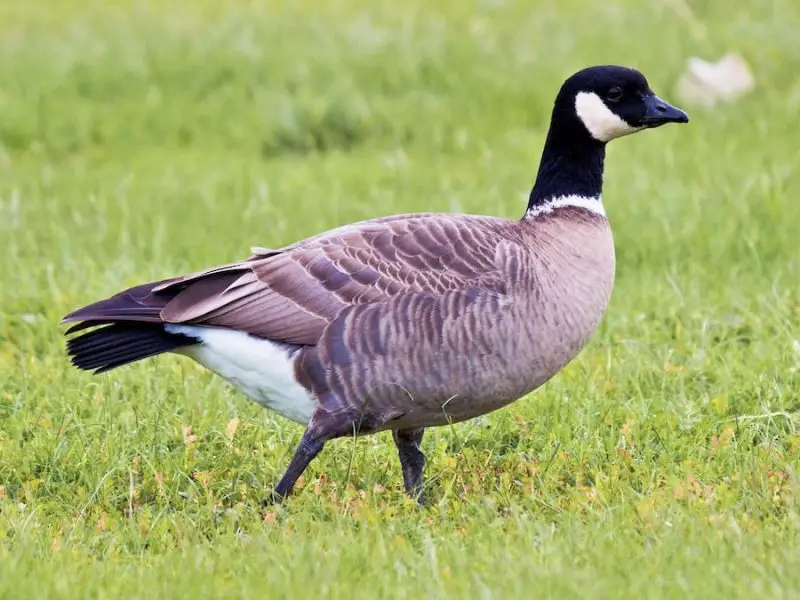
A Tiny Twin with a Voice of Its Own
At first glance, the Cackling Goose looks like a mini version of the Canada Goose—but don’t be fooled. This compact species has earned its place as a distinct bird with unique features that set it apart from its larger cousin. With its shorter neck, rounder head, and petite, stubby bill, the Cackling Goose carries a charm all its own.
What really makes it stand out is its signature high-pitched “cackle”, a nasal, laughing call that echoes across fields during migration. Unlike the deep honks of Canada Geese, this goose’s voice sounds more like a cartoon giggle—often the first clue that birders have spotted something special in a sea of familiar faces.
Cackling Geese are most commonly observed in mixed flocks during late fall and early spring, especially in open agricultural lands, prairie potholes, and flooded fields where they stop to rest and feed. Their smaller size and tighter body proportions require keen eyes and experience to detect, making each sighting a rewarding challenge for dedicated birdwatchers.
Once considered just a subspecies of the Canada Goose, the Cackling Goose is now recognized as its own species—a testament to the subtle complexity and ever-evolving understanding of bird diversity in Michigan’s skies.
3. Snow Goose (Anser caerulescens)
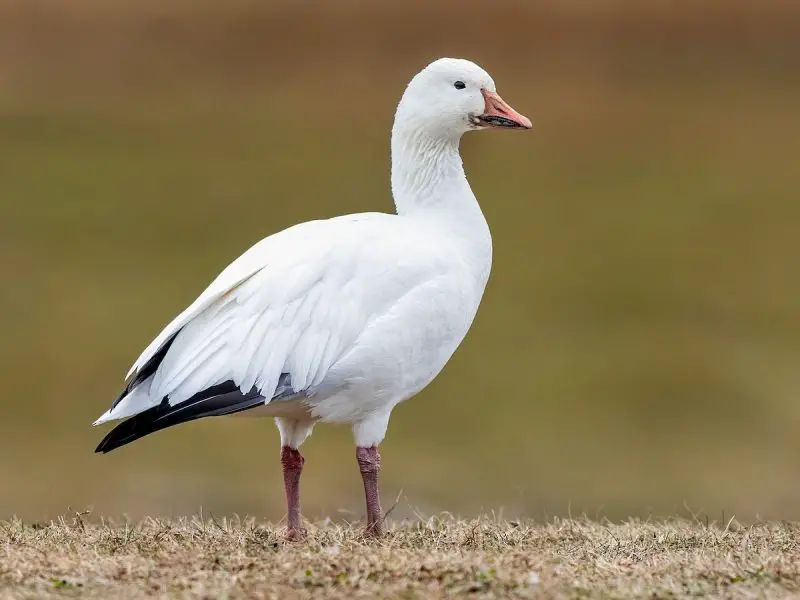
Migratory Marvels in White and Blue
When thousands of white birds swirl through the Michigan sky like windblown snow, it’s not a storm—it’s the arrival of Snow Geese, one of the most spectacular migration events in the Midwest. These eye-catching birds are best known for their brilliant white plumage accented by jet-black wingtips, which shimmer in the sunlight as flocks shift and turn in unison.
But not all Snow Geese wear white. Some individuals display a dramatic “blue morph,” with slate-gray bodies, white heads, and contrasting dark feathers—a striking variation that adds depth and texture to any migrating flock. Both morphs belong to the same species and may even occur within the same family group.
Snow Geese travel in enormous, noisy flocks that sometimes number in the tens of thousands, creating a rolling tide of honks and wingbeats across Michigan’s farmlands, wetlands, and flooded meadows. Their arrival—typically in early spring and late fall—often signals a change in seasons, drawing birders from across the state hoping to witness the aerial ballet.
Whether wheeling high above a cornfield or descending en masse onto a flooded plain, Snow Geese are more than just seasonal visitors—they are symbols of movement, change, and the untamed rhythm of migration that defines Michigan’s dynamic bird life.
4. Ross’s Goose (Anser rossii)
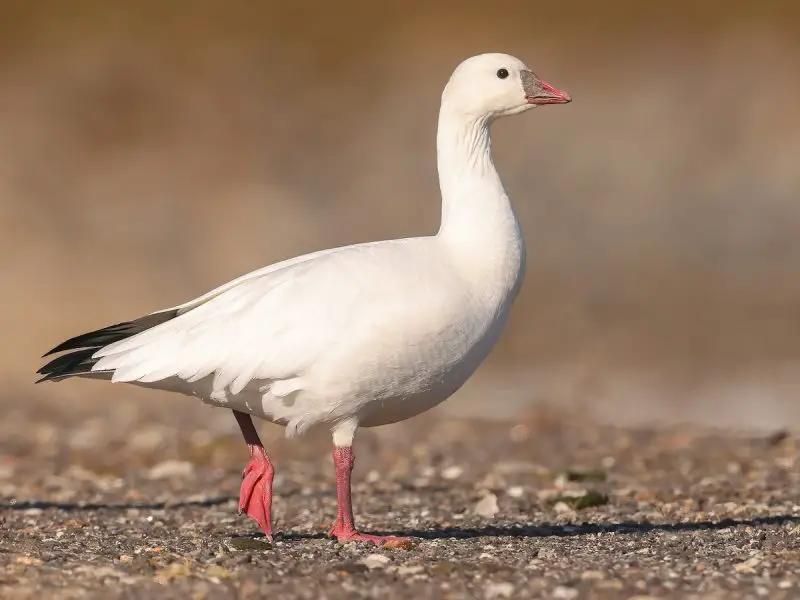
A Compact Gem Among the Snowy Clouds
Like a miniature version of its better-known cousin, the Ross’s Goose is a petite, elegant relative of the Snow Goose, sharing its crisp white plumage and black wingtips—but with subtle features that reward a careful observer. Measuring only about two-thirds the size of a Snow Goose, Ross’s Goose has a rounder head, shorter neck, and a delicate, stubbier bill that lacks the dark “grinning patch” seen on its larger kin.
This small stature gives the Ross’s Goose a daintier, more buoyant appearance both in flight and on the ground. It is also quieter, with gentler vocalizations that can be lost amid the roar of migrating flocks.
Though not as abundant as Snow Geese, Ross’s Geese are regular migrants in Michigan, especially in open farmlands, marshes, and wetlands during peak migration in late fall and early spring. They often travel with large flocks of Snow Geese, making them a delightful discovery for birders who scan closely.
Spotting a Ross’s Goose requires sharp optics and attention to detail, but for those who succeed, it offers the thrill of finding a hidden gem nestled among a snow-white sea of wings.
5. Greater White-fronted Goose (Anser albifrons)
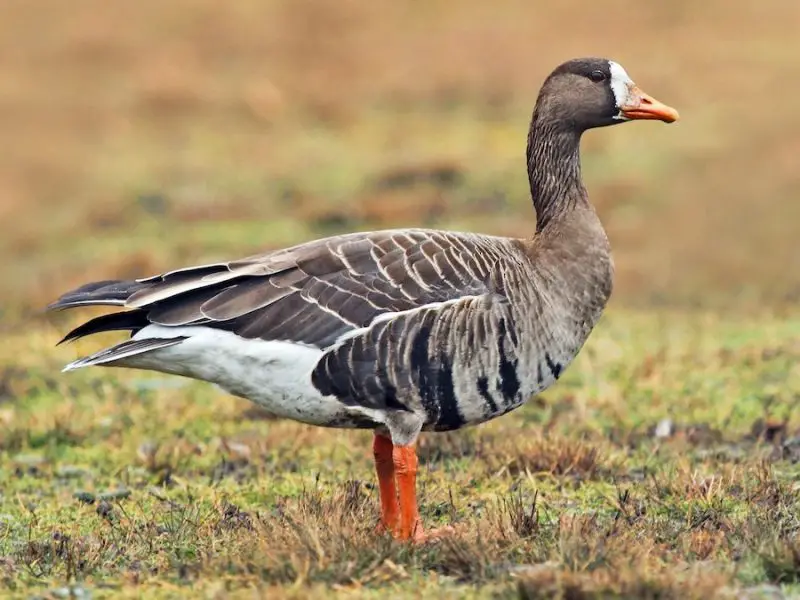
The Specklebellied Traveler with a Splash of Color
Among the flocks of gray and brown geese dotting Michigan’s fields in late fall, the Greater White-fronted Goose stands out with its bold accents and subtle elegance. Named for the distinctive white crescent that wraps around the base of its pinkish-orange bill, this goose wears a speckled belly that gives rise to its popular nickname—“Specklebelly.”
Its bright orange legs and mottled chest contrast beautifully with its soft brown back and wings, making it one of the more colorful and charming members of the waterfowl world. Though often overshadowed by more common species, the Greater White-fronted Goose is a favorite among experienced birders for its rarity and striking appearance.
In Michigan, these geese are relatively uncommon but consistently observed during migration, especially in late autumn, as they pass through in search of resting and feeding grounds. They tend to mix with large flocks of Canada Geese, foraging in wetlands, corn stubble fields, and flooded grasslands.
Their high-pitched, yelping calls—often described as “laughing”—are another giveaway, setting them apart from the deeper honks of their companions. Catching sight of a Greater White-fronted Goose adds a rewarding touch of variety to any migration season and offers a reminder of the vast distances these birds travel between Arctic breeding grounds and their southern winter homes.
6. Brant (Branta bernicla)
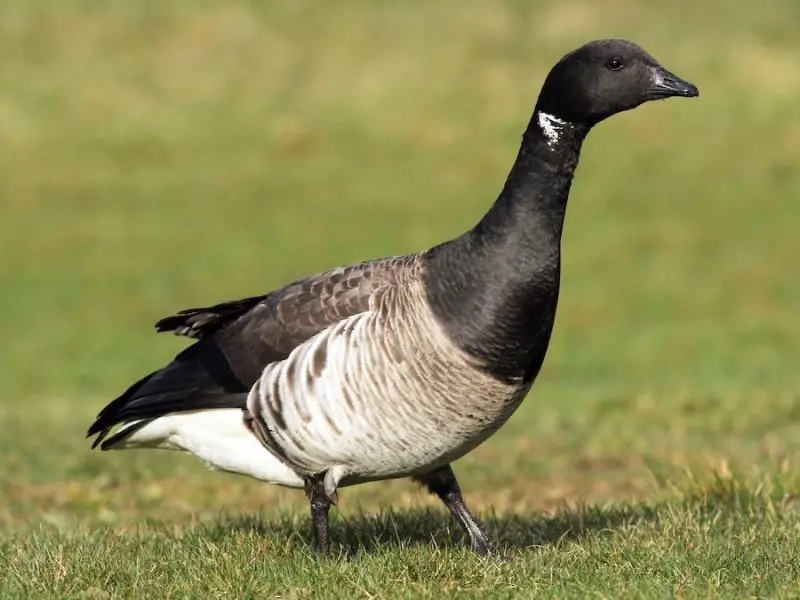
A Rare Coastal Wanderer on Inland Shores
With their compact build and striking black-and-white plumage, Brant geese are unmistakable—if you’re lucky enough to see one in Michigan. These Arctic-breeding coastal specialists are most commonly associated with salt marshes and Atlantic shorelines, where they spend their winters feeding on eelgrass and sea lettuce. But every so often, a few adventurous individuals stray inland, offering a rare treat for Great Lakes birders.
The Brant’s appearance is elegant and understated. Their black heads and chests contrast with whitish bellies and a distinctive white collar patch on their short, thick necks. They are noticeably smaller and sleeker than Canada Geese, with a more delicate, agile flight style.
In Michigan, Brant are considered rare migrants, sometimes turning up along the shores of Lake Michigan or Lake Huron during spring or fall migration. Most sightings are fleeting—single birds or small flocks resting briefly on beaches, bays, or open water before continuing their journey.
For seasoned birders, spotting a Brant in Michigan is an exciting challenge that blends patience, timing, and a bit of luck. Their presence reminds us of the vast migratory networks that link far-flung ecosystems—from the windswept tundra of the north to the salty estuaries of the east—occasionally bringing coastal life to inland shores.
7. Pink-footed Goose (Anser brachyrhynchus)
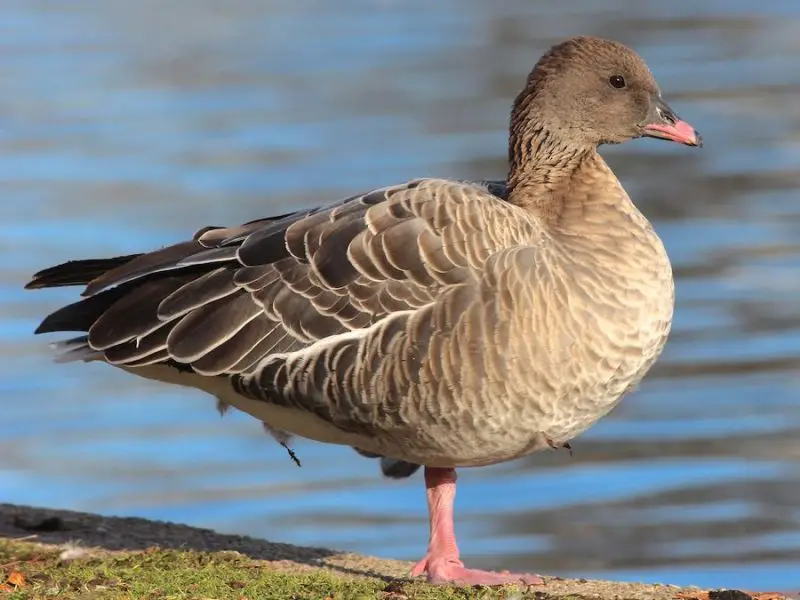
A Transatlantic Surprise from the Far North
Among the rarest waterfowl ever spotted in Michigan, the Pink-footed Goose is a true globe-trotter—a bird of the Old World that occasionally stuns North American birders with an unexpected appearance. Native to the rugged tundras of Greenland and Iceland, this compact, attractive goose winters in Western Europe and was once unknown on this side of the Atlantic.
In recent decades, however, a handful of Pink-footed Geese have strayed across the ocean, joining flocks of other geese in Canada and the northeastern United States. Their presence in Michigan is extremely rare, but not impossible—especially in late fall or early winter, when a few vagrants may pause in fields or wetlands with migrating Snow or Canada Geese.
This species is easily recognized by its rosy-pink bill and legs, grayish-brown plumage, and more refined, compact body compared to larger relatives. It lacks the bold white markings of other geese, giving it a soft, understated beauty.
Because sightings are so unusual, every confirmed Pink-footed Goose draws large crowds of birders and photographers, often traveling hundreds of miles for a glimpse. State ornithological records committees carefully document such encounters, as each new report contributes valuable data to our understanding of vagrancy and climate-related shifts in migration patterns.
Seeing a Pink-footed Goose in Michigan is more than a rare birding trophy—it’s a reminder of the global connections in nature, where even a bird from across the ocean might one day touch down in a cornfield near you.
Where and When to See Wild Geese in Michigan
Best Seasons for Goose Watching
Most goose activity in Michigan peaks during spring (March–April) and fall (October–November) migration. During these times, you can see thousands of geese passing through the state’s major flyways.
In winter, Canada Geese remain in southern parts of the state, while rarer species may be found among them in unfrozen lakes and agricultural fields. Summer is quieter, though resident Canada Geese remain active near lakes and city parks.
Prime Birding Locations
-
Saginaw Bay – Excellent for Snow and Ross’s Geese during migration.
-
Shiawassee National Wildlife Refuge – A hotspot for Cackling and White-fronted Geese.
-
Pointe Mouillee State Game Area – Ideal for large mixed flocks in fall.
-
Sleeping Bear Dunes and Lake Huron shores – Occasionally host Brant or other rarities.
Conservation and Coexistence
Keeping Balance in Goose Populations
While geese are admired for their migration and adaptability, large resident Canada Goose populations have raised concerns in urban areas due to overgrazing and aggressive behavior. Managing goose populations through habitat control and ethical deterrents remains an ongoing challenge.
At the same time, the appearance of rare species like the Pink-footed Goose or Brant highlights the importance of habitat preservation and international migratory protection efforts. Michigan’s wetlands, rivers, and fields serve as critical stopover points in a much larger ecological web.
Conclusion
From familiar Canada Geese to surprise appearances by European vagrants, Michigan hosts a rich diversity of wild goose species. Whether you’re a seasoned birder or a casual nature lover, keeping your eyes to the skies and fields during migration season can lead to unforgettable sightings. Understanding and appreciating these majestic birds not only deepens your connection to Michigan’s wild spaces but also helps support their conservation for generations to come.

